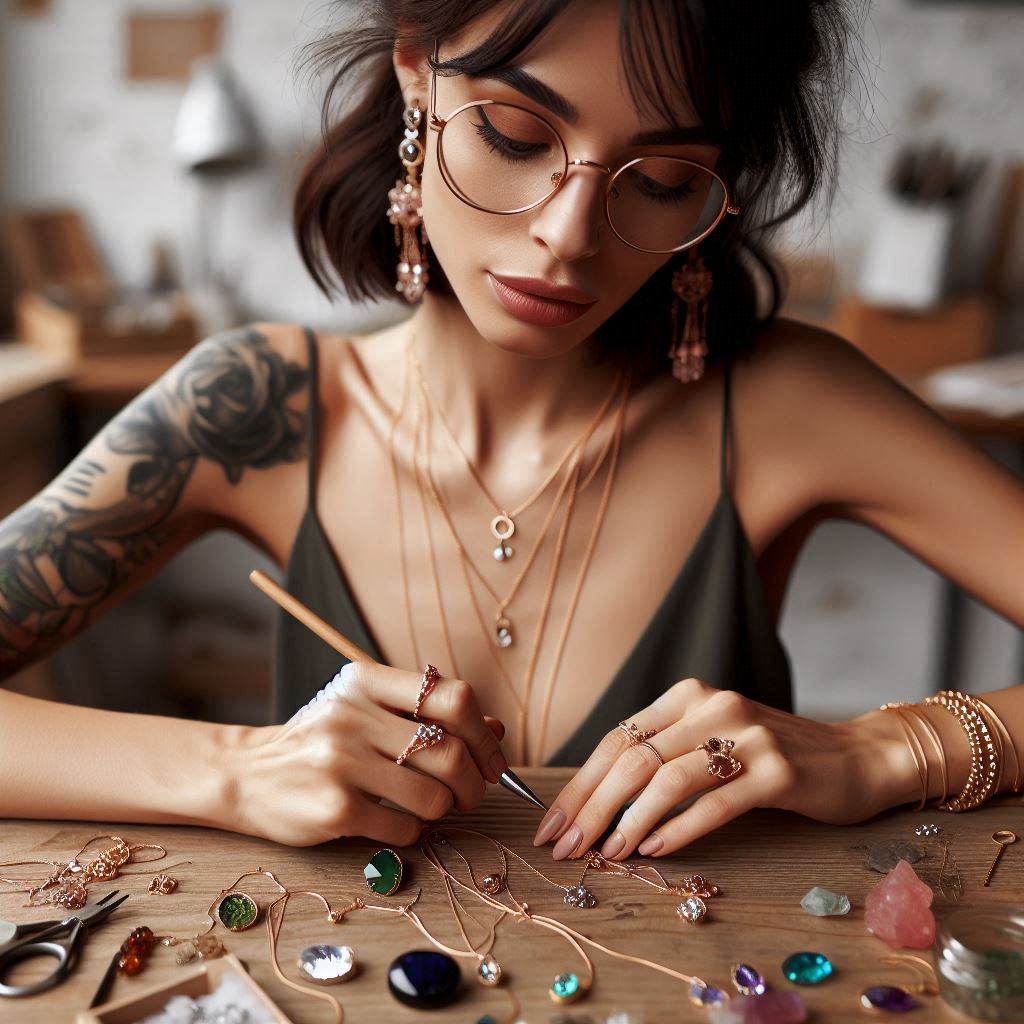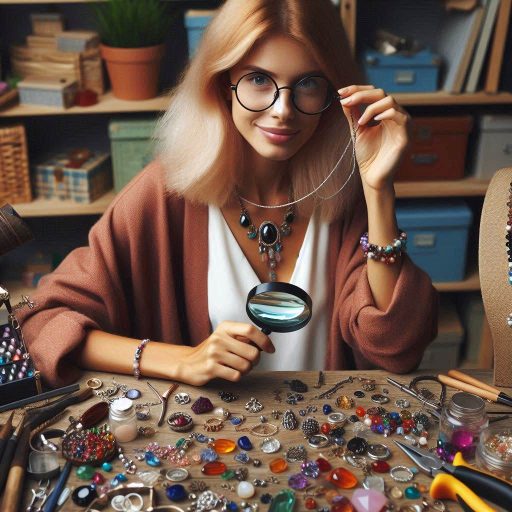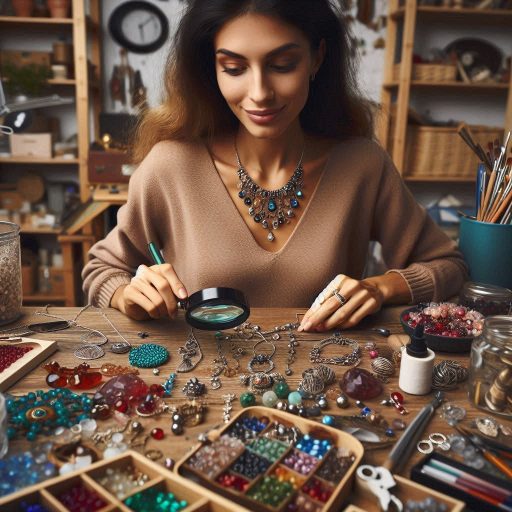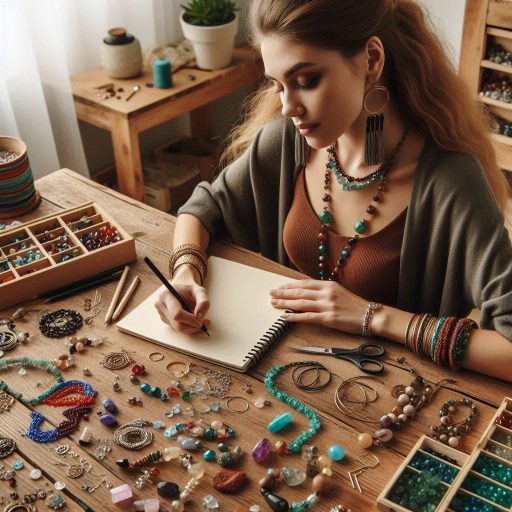Introduction
Why crafting unique jewelry is a popular and rewarding hobby
Crafting unique jewelry allows individuals to express their creativity while creating something truly personal.
Unlike mass-produced pieces, handmade jewelry reflects the maker‘s style, taste, and vision.
This craft has been gaining popularity because it lets people make distinctive accessories that tell a story or hold sentimental value.
Whether it‘s a necklace, bracelet, or earrings, creating your own jewelry brings a sense of accomplishment.
The process of turning raw materials into a finished product is rewarding, offering a creative outlet and the satisfaction of producing something beautiful by hand.
Crafting unique jewelry can also be therapeutic.
Many people find the hands-on nature of this hobby to be relaxing and a way to de-stress.
It requires concentration and focus, which can provide a mental escape from daily life.
The joy of seeing your vision come to life adds another layer of satisfaction.
Jewelry making also opens up endless possibilities for design, allowing you to play with different shapes, textures, and colors.
This freedom to experiment with materials and techniques adds excitement to the hobby.
Rising trend of DIY jewelry and the satisfaction of wearing your own creations
The DIY jewelry trend has taken off as more people seek personalized, handcrafted pieces.
Crafting your own jewelry gives you complete control over the design and materials, allowing for one-of-a-kind creations that can’t be found in stores.
The rise of online tutorials, craft stores, and jewelry-making kits has made it easier than ever to start this rewarding hobby.
Social media platforms like Pinterest and Instagram have fueled interest by providing inspiration and showcasing the work of talented crafters.
As more people embrace handmade, sustainable fashion, DIY jewelry has become a popular way to create accessories that match individual styles.
There‘s a special kind of pride in wearing something you‘ve made yourself.
Each piece carries a unique story and personal meaning.
Whether you‘re crafting for yourself or as a gift for someone else, the end result is always rewarding.
Wearing your own creations is not only a fashion statement but also a conversation starter.
People often admire and ask about handmade jewelry, giving you a chance to share the story behind the piece.
This sense of accomplishment and personal connection adds to the appeal of DIY jewelry making, making it more than just a hobby.
Crafting unique jewelry is not only a creative endeavor but also a fulfilling one.
As the trend continues to grow, more people are discovering the joy of making their own accessories.
It allows you to showcase your creativity, express your individuality, and enjoy the satisfaction of wearing something that you brought to life with your own hands.
Choosing the Right Materials
Importance of selecting high-quality materials for jewelry making
When crafting unique jewelry, selecting high-quality materials is essential.
The materials you choose will determine the durability, appearance, and value of your creations.
High-quality metals, stones, and beads ensure that your jewelry lasts longer and withstands daily wear.
In addition, using premium materials enhances the overall aesthetic, giving your pieces a more professional and polished look.
Quality materials also allow you to charge a premium for your work, attracting customers who appreciate craftsmanship and are willing to pay for long-lasting, beautiful designs.
Ensuring you use the best possible materials will elevate your jewelry-making skills.
Not only do high-quality materials enhance the visual appeal of your jewelry, but they also impact the safety and comfort of the wearer.
Cheap metals can cause allergic reactions or discoloration on the skin, which may tarnish your reputation as a jeweler.
By selecting hypoallergenic metals, such as sterling silver or surgical steel, you can create jewelry that is safe for all skin types.
Additionally, investing in durable clasps and findings will prevent your pieces from breaking easily, ensuring that your customers are satisfied with their purchase and are likely to return for more.
Tips on where to find unique beads, charms, and other supplies to make your pieces stand out
Finding unique beads, charms, and supplies is key to crafting jewelry that stands out.
One of the best places to find distinctive materials is local craft markets or artisan fairs.
These venues often feature handmade, one-of-a-kind beads and charms that are not available in larger chain stores.
By sourcing from local artists, you not only support small businesses but also add a unique touch to your creations that sets your jewelry apart from mass-produced pieces.
Online marketplaces like Etsy and specialized bead shops are also excellent sources for unique materials.
These platforms offer a wide variety of supplies, from vintage charms to custom-made beads that can give your designs a distinct flair.
When shopping online, be sure to read reviews and check the seller‘s reputation to ensure you are purchasing high-quality items.
You can also explore international websites for beads and materials that reflect different cultural influences, adding a global appeal to your jewelry.
Another tip is to upcycle old jewelry or thrifted pieces for materials.
Repurposing beads, charms, or even chains from second-hand stores not only helps the environment but also provides you with unique components that are often no longer in production.
This approach allows you to craft one-of-a-kind pieces that are both sustainable and special, giving your jewelry a story that customers will love.
Read: Collaborating with Other Creative Roles
Design Inspiration
Different Sources of Inspiration for Creating Unique Jewelry Designs
Finding inspiration for unique jewelry designs begins with exploring a variety of sources.
Nature provides one of the most abundant sources of inspiration.
Observing the patterns found in flowers, leaves, and gemstones can spark new ideas.
You can take a walk in a park or garden to notice the small details around you.
Another great source of inspiration comes from art and architecture.
Historical art movements like Art Deco, Art Nouveau, and even modern minimalist designs offer a wealth of inspiration.
By studying the forms and materials used in these art movements, you can incorporate those elements into your jewelry designs.
You might also find inspiration in cultural artifacts and traditional jewelry designs from various regions of the world.
Visiting museums or researching online can open your mind to how different cultures approach jewelry making.
Don‘t be afraid to blend different styles together to create something entirely new.
Combining inspirations from different sources helps you craft pieces that stand out.
Tips on How to Stay Creative and Original in Your Designs
Staying creative and original as a jewelry designer requires constant exploration and a willingness to experiment.
One of the most effective ways to maintain your creativity is by sketching regularly.
Keeping a design journal where you sketch your ideas allows you to revisit and refine them over time.
Experiment with different materials, shapes, and textures to push the boundaries of traditional jewelry design.
You can try mixing metals, incorporating non-traditional materials like leather or wood, or experimenting with asymmetrical designs.
Another tip is to collaborate with other designers or artists from different disciplines.
By exchanging ideas, you can gain fresh perspectives and learn new techniques.
Additionally, taking breaks and stepping away from your work can also help reignite your creativity.
A short trip or simply engaging in a different hobby can refresh your mind and bring new ideas.
Staying updated on trends while remaining true to your unique vision is key.
While it’s important to know what’s trending, don‘t feel pressured to follow every trend.
Instead, use trends as a way to enhance your original ideas rather than letting them dominate your designs.
This approach ensures that your jewelry remains both current and uniquely yours.
Lastly, continuously seek feedback from clients or fellow designers.
Constructive criticism can provide valuable insights and open up new ways to approach your designs.
Always be open to learning and evolving.
The jewelry design field is ever-changing, and staying curious and adaptable is essential to maintaining originality.
Through consistent practice, exploration, and a willingness to innovate, you can continue to create jewelry that is both creative and true to your personal style.
Read: Freelance vs. In-House Costume Design Jobs
Techniques and Skills
When learning how to create unique jewelry, mastering various techniques and skills is essential.
These skills provide the foundation for making creative and high-quality pieces that stand out.
Every aspiring jewelry maker should focus on developing these fundamental techniques before moving on to advanced designs.
By building these skills, you will gain the confidence and ability to explore more complex projects and develop your own style.
Essential jewelry-making techniques and skills that beginners should learn
Beginners in jewelry making need to focus on learning basic techniques that form the core of the craft.
One of the most fundamental skills is wire wrapping.
This technique involves wrapping wire around gemstones or beads to create beautiful, sturdy designs.
Bead stringing is another crucial skill that helps in making necklaces, bracelets, and anklets with ease.
Knotting is also vital for stringing beads on silk cords, adding elegance to your designs.
Soldering is an advanced skill that beginners should eventually learn.
This technique allows for joining metal pieces using heat, opening up endless possibilities for creating intricate designs.
Properly learning how to use pliers and cutters to manipulate wires and metal is essential for shaping your designs effectively.
By focusing on these foundational techniques, beginners can start crafting jewelry that is both creative and structurally sound.
Step-by-step instructions or links to tutorials for mastering these skills
To master the fundamental jewelry-making skills, beginners should follow step-by-step instructions that provide clear guidance.
First, start by practicing wire wrapping using a variety of gauges and beads.
You can find tutorials online that guide you through wrapping wires around stones and beads.
One helpful resource is YouTube, where many creators share detailed videos demonstrating each step.
Next, practice bead stringing by using elastic cords or metal wires.
Begin with simple designs, and gradually incorporate more complicated patterns.
Online tutorials like those found on Pinterest and crafting websites offer easy-to-follow instructions for creating necklaces, bracelets, and earrings.
You can also purchase jewelry-making kits that include guides for learning bead stringing.
For soldering, it‘s important to first understand safety precautions.
Start by learning to heat small pieces of metal and join them carefully.
Look for online classes that offer both visual and written instructions to help with mastering this technique.
You can visit Craftsy and Skillshare for in-depth courses on soldering, wirework, and stone setting.
By following tutorials and practicing these essential techniques regularly, beginners can develop strong jewelry-making skills.
Each technique plays a key role in crafting unique and intricate designs.
With patience and practice, you will become proficient in these skills and able to create stunning, one-of-a-kind jewelry pieces.
Read: Networking Events for Costume Designers

Personalization and Customization
Customizing jewelry allows you to create pieces that reflect your style and preferences.
Instead of settling for mass-produced designs, customization gives you control over every detail.
This makes the jewelry more meaningful and unique.
Personalizing your pieces also adds sentimental value, especially when you design them to symbolize special moments or relationships.
By tailoring jewelry to your tastes, you can create something truly one-of-a-kind.
Customized pieces often become cherished keepsakes, passed down through generations.
The process of personalizing jewelry ensures that each piece tells a story unique to you, making it more valuable and personal.
Benefits of Customizing Jewelry to Suit Your Own Style and Preferences
Customizing jewelry allows you to express your individuality and creativity.
When you design pieces based on your preferences, you ensure that they match your style perfectly.
This is especially useful if you find it difficult to purchase ready-made jewelry that aligns with your fashion sense.
Custom jewelry can be designed to fit specific occasions, making it versatile and suitable for any event.
Additionally, you can choose materials that suit your skin type or preferences, such as hypoallergenic metals or specific gemstones.
Overall, customization gives you complete control over the design process, ensuring that your jewelry aligns with your personal taste and style.
Ideas on How to Personalize Jewelry Through Engraving, Stamping, or Incorporating Birthstones
There are several ways to personalize jewelry, with engraving being one of the most popular methods.
Engraving allows you to add meaningful names, dates, or quotes to your pieces, making them more personal.
Whether it‘s a special date or a loved one‘s name, engraving can make the jewelry more sentimental.
Stamping is another effective way to customize jewelry.
Stamped designs can include symbols, initials, or even motivational words.
Finally, incorporating birthstones adds a personal touch to any piece of jewelry.
Birthstones can represent the wearer‘s birth month or someone special in their life.
Customizing with birthstones makes the piece both beautiful and meaningful.
By combining these techniques, you can create personalized jewelry that speaks to you.
Engraving adds words and memories, stamping enhances the design with symbols or initials, and birthstones create emotional connections.
Each method of personalization makes the jewelry more special and unique to the wearer, creating a piece that truly stands out.
Read: Visual Merchandising: Best Practices for Beginners
Mixing Materials and Textures
Tips on how to mix different materials and textures to create visually interesting pieces
To craft unique jewelry, mixing different materials and textures can dramatically elevate your designs.
Start by experimenting with a variety of metals, such as gold, silver, and copper.
The contrast between these materials can produce a captivating effect, making each piece stand out.
Don’t shy away from combining hard and soft textures, like rigid metals with flexible leather or fabric.
This approach creates an unexpected visual interest that appeals to many.
Additionally, using matte and shiny finishes together can further enhance the overall appeal of your jewelry, making it more dynamic and eye-catching.
The key is to experiment with various materials and textures until you find a harmonious balance that reflects your artistic vision.
When mixing materials, it is essential to consider the weight and durability of each component.
Some materials, like gemstones or beads, may be heavier than others, which could affect the wearability of your design.
Make sure to balance the weight throughout the piece to avoid discomfort for the wearer.
Furthermore, you can layer different textures to create depth.
For instance, adding small fabric accents to metal jewelry can soften its appearance and provide a striking contrast.
Texture plays a significant role in how a piece feels and looks, making it a crucial element in crafting visually stunning jewelry.
How combining metals, gemstones, and beads can add depth and complexity to your designs
Incorporating a variety of metals, gemstones, and beads into your jewelry designs can add layers of depth and complexity.
Metals offer a sturdy foundation, while gemstones and beads introduce color, texture, and shine.
By carefully selecting and combining these materials, you can create unique patterns and designs that resonate with your style.
For example, pairing a polished silver chain with rough, uncut gemstones creates a visually appealing contrast that draws attention to your work.
You can also mix different types of gemstones, like pairing diamonds with sapphires, to create a more luxurious and intricate look.
When adding beads to your designs, you can use them to introduce pops of color and texture.
Beads come in various materials such as glass, wood, or ceramic, each offering a distinct texture and feel.
Mixing beads with metals can bring a playful or elegant element to your jewelry.
For instance, glass beads paired with gold give your piece a delicate yet sophisticated vibe.
Gemstones also provide a range of textures and colors, allowing you to create jewelry that speaks to various tastes and preferences.
Combining these elements adds a sense of richness and detail to your designs, making each piece more engaging and meaningful.
You Might Also Like: Salary Expectations for Product Designers in the USA
Incorporating Trends
Incorporating trends into your unique jewelry designs helps keep your work relevant and desirable.
Staying updated on the latest styles is essential, as clients often look for pieces that reflect modern tastes.
Integrating trends doesn’t mean compromising your creativity or originality.
Instead, it allows you to enhance your designs by adding trendy elements that appeal to current fashion.
By paying attention to fashion shows, social media, and jewelry influencers, you can gather inspiration and incorporate those trends into your creations.
The key is to adapt these trends to match your own unique style and vision.
Transform Your Career Today
Unlock a personalized career strategy that drives real results. Get tailored advice and a roadmap designed just for you.
Start NowHow to incorporate current jewelry trends into your unique designs
To successfully incorporate current jewelry trends into your unique designs, start by identifying which trends resonate with your brand.
You can blend these popular elements into your signature style, ensuring that your pieces remain true to your artistic vision.
Whether it’s playing with textures, incorporating new materials, or altering colors, these small adjustments can keep your designs fresh without losing their individuality.
A careful balance between trendy and unique will help your jewelry stand out in the competitive market.
Additionally, subtle variations in design can make a trendy piece more exclusive and personalized.
Once you’ve identified a trend, consider how it can complement your existing designs.
For instance, if bold colors are trending, think about how to incorporate them through gemstones or beads in your pieces.
You don‘t need to overhaul your style completely; instead, use the trend to elevate and refine your creations.
It‘s also helpful to focus on trends that align with the preferences of your target audience.
Understanding what appeals to them can ensure that you create pieces that they will love, while maintaining the unique identity of your brand.
Examples of popular trends such as layering necklaces or statement earrings
Popular trends like layering necklaces and statement earrings can easily be adapted into unique designs.
Layering necklaces, for example, offer versatility by allowing wearers to mix and match multiple pieces.
To incorporate this trend, you can design necklaces in various lengths and styles that complement each other.
Creating sets with different textures, pendants, or chains ensures that your designs offer a cohesive and fashionable look.
The beauty of this trend lies in its ability to showcase more than one piece of jewelry at once, giving wearers the opportunity to express their personal style.
Statement earrings, on the other hand, are perfect for making a bold fashion statement.
These large, eye-catching pieces can become the centerpiece of an outfit.
When designing statement earrings, think about using vibrant colors, intricate shapes, and unique materials to create pieces that capture attention.
While the trend calls for boldness, you can still maintain the uniqueness of your designs by incorporating elements like asymmetry or handmade details.
By carefully integrating these popular trends into your work, you can offer jewelry that appeals to fashion-conscious clients while staying true to your creative vision.
Proper Care and Maintenance
Taking proper care of your handmade jewelry is essential for maintaining its beauty and longevity.
Handmade pieces often involve delicate materials that require special attention.
Following a few simple steps can help you preserve your jewelry‘s appearance and durability for years to come.
By practicing regular maintenance, you‘ll also prevent damage and avoid the need for costly repairs.
Proper care not only enhances the lifespan of your pieces but also ensures they remain a reflection of your creativity.
Offer advice on how to properly care for and store your handmade jewelry
To ensure your handmade jewelry lasts, proper storage is key.
Store your pieces in a cool, dry place, away from direct sunlight and moisture.
You should also consider keeping them in individual pouches or boxes to prevent tangling and scratching.
If you work with different materials, such as metal and gemstones, store them separately to avoid chemical reactions or scratches.
Hanging necklaces and using soft, padded storage containers for other items is also effective.
Proper storage can protect your pieces from environmental factors that may damage or tarnish them.
Tips on cleaning, polishing, and repairing jewelry to ensure longevity
Regular cleaning is crucial to keep your jewelry looking its best.
Use a soft cloth to gently wipe away dust and oils after each wear.
For more thorough cleaning, use mild soap and lukewarm water.
Avoid harsh chemicals, as they can damage certain materials like gemstones or delicate metals.
Polishing your pieces occasionally with a jewelry cloth can help maintain their shine and luster.
If your jewelry includes gemstones, check them regularly for any signs of loosening.
In case of minor damage, such as a broken clasp or chain, simple repairs like replacing a clasp or reattaching a piece can extend the life of your jewelry.
By incorporating these practices into your routine, you ensure your handmade jewelry remains as beautiful and unique as the day you created it.
Proper care and maintenance not only protect the materials but also preserve the sentimental value and artistry of each piece.
Conclusion
Importance of crafting unique jewelry as a creative and fulfilling hobby
Crafting unique jewelry offers a rewarding experience, allowing you to express your creativity through wearable art.
Unlike store-bought pieces, handmade jewelry reflects your personal touch, making each item one-of-a-kind.
This sense of originality adds immense value to your creations, turning jewelry-making into more than just a hobby.
It becomes a means of self-expression and emotional fulfillment.
As you design each piece, you tap into your creativity, developing new ideas and honing your skills.
The joy of seeing your vision come to life in a finished piece brings satisfaction that is both tangible and meaningful.
In addition to the creative outlet, jewelry crafting provides a calming, meditative activity.
The process of working with your hands, whether stringing beads or shaping metals, requires focus and patience.
These aspects not only help improve your craftsmanship but also contribute to stress relief and mental clarity.
As you practice more, you may discover new techniques and styles that align with your creative vision.
Each completed piece, from earrings to necklaces, represents a step forward in your jewelry-making journey, making the hobby both productive and enjoyable.
Experiment with different techniques and materials to make their jewelry truly one-of-a-kind
Experimentation is key to making your jewelry stand out.
By trying out different techniques, such as wire wrapping, bead weaving, or metal stamping, you can push the boundaries of your creativity.
Each method offers a unique way to manipulate materials and create distinctive designs.
For example, wire wrapping allows for intricate, delicate patterns, while metal stamping adds bold, personalized touches.
The more techniques you explore, the more versatile your jewelry collection will become, giving you endless possibilities to work with.
Equally important is experimenting with materials.
Don’t limit yourself to traditional beads or metals.
Try incorporating unconventional items like sea glass, leather, or even recycled materials into your designs.
These alternative materials can give your pieces a rustic, eco-friendly appeal or a modern, edgy look.
When you step outside the box with your material choices, you not only make your jewelry more unique but also set trends that others may follow.
With each new material you try, you open the door to exciting creative challenges and discoveries.
Overall, the combination of varied techniques and diverse materials ensures that your jewelry is truly one-of-a-kind.
By continuously experimenting, you keep your designs fresh and exciting, preventing creative stagnation.
The more risks you take with your jewelry-making, the more likely you are to create pieces that genuinely stand out from the crowd.
So embrace the challenge, have fun with the process, and let your imagination guide you to create stunning, original jewelry.
[E-Books for Sale]
The Big Book of 500 High-Paying Jobs in America: Unlock Your Earning Potential
$19.99 • 500 High-Paying Jobs • 330 pages
Explore 500 high-paying jobs in America and learn how to boost your career, earn more, and achieve success!
See All 500 High-Paying Jobs of this E-Book
1001 Professions Without a Degree: High-Paying American Jobs You Can Start Now
$19.99 • 1001 Professions Without a Degree • 174 pages
Discover 1001 high-paying jobs without a degree! Unlock career tips, skills, and success strategies for just $19.99!




